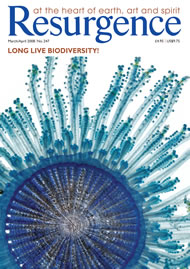MOST READERS WILL be familiar with the premises of organic gardening; perhaps not so many with biodynamic gardening, which requires a greater commitment to growing practices, uses lunar rhythms in cultivation and has some unique preparations for making compost, conditioning the soil and promoting healthy growth. This colourful manual provides a friendly introduction to Maria Thun and her lifetime’s growing experience.
Thun began gardening in post-war Germany when food was scarce and self-sufficiency essential. Drawing on the folk calendar of her farming background, connecting seasonal rhythms with Christian saints’ days and Rudolf Steiner’s work on agriculture, she began to discover another dimension to her gardening, observing how sowing, planting, cultivating and harvesting were all affected by the moon. Each plant group has its optimum work pattern, depending on the part of the plant you wish to use, be it root, leaf, flower or fruit. Thun’s lunar calendar, published annually, gives guidance on the best days for all practices, and is based, not on the ephemeris used by most astrologers, but on the position of the stars as they are now, following the procession of the equinoxes. Old weather lore now needs adjusting since the sun’s position shifts by one degree every seventy-two years. Some years ago I tried to follow the calendar; I found it useful and demanding and drew from it the imperative to attune myself daily to the task in hand. The mettle of biodynamic gardeners I have met and the quality of their produce are inspiring.
Biodynamic gardening uses manure, silica and cowpats prepared by dilution and agitation, a little like homeopathic remedies; for the silica preparation an hour is spent stirring 0.5g of material in 4–5l of water. Plant teas are also made to optimise growing conditions; nettle tea is familiar to many as an excellent plant food or compost activator, but yarrow, camomile, dandelion, oak bark and valerian are also used. In her introduction Thun quotes from Steiner’s Agriculture Course: “Farmers should become ‘olfactorily clairsentient’.” Her knowledge of plants is founded on intense childhood acquaintances with the scents of herbs, berries and meadow flowers. This book presents biodynamic growing with practical simplicity; and no explanations of anthroposophical theory are needed to appreciate it.
Thun’s garden enjoys a northerly continental climate, with cold winters and warm summers, though these climate patterns are becoming less reliable. Her routines will need adapting for your own locale, but her dedication and continuous research are truly inspiring. It is as though your grandmother had made you a scrapbook, full of good photographs and diagrams as well as encouraging explanations. Thun’s introduction implies that it is intended “to help our children gain a closer connection to the plant world...then gardens can become a valuable source of strength for us”. I am then still a child, ready to keep this book in the potting shed through the summer, to refine my observance and gardening practice, and reawaken my beginner’s mind.







